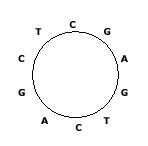UVa 1584 - Circular Sequence
来源:互联网 发布:javascript对象转json 编辑:程序博客网 时间:2024/04/29 16:17
Some DNA sequences exist in circular forms as in the following figure, which shows a circular sequence ``CGAGTCAGCT", that is, the last symbol ``T" in ``CGAGTCAGCT" is connected to the first symbol ``C". We always read a circular sequence in the clockwise direction.

Since it is not easy to store a circular sequence in a computer as it is, we decided to store it as a linear sequence. However, there can be many linear sequences that are obtained from a circular sequence by cutting any place of the circular sequence. Hence, we also decided to store the linear sequence that is lexicographically smallest among all linear sequences that can be obtained from a circular sequence.
Your task is to find the lexicographically smallest sequence from a given circular sequence. For the example in the figure, the lexicographically smallest sequence is ``AGCTCGAGTC". If there are two or more linear sequences that are lexicographically smallest, you are to find any one of them (in fact, they are the same).
Input
The input consists of T test cases. The number of test cases T is given on the first line of the input file. Each test case takes one line containing a circular sequence that is written as an arbitrary linear sequence. Since the circular sequences are DNA sequences, only four symbols, A, C, G and T, are allowed. Each sequence has length at least 2 and at most 100.
Output
Print exactly one line for each test case. The line is to contain the lexicographically smallest sequence for the test case.
The following shows sample input and output for two test cases.
Sample Input
2 CGAGTCAGCT CTCC
Sample Output
AGCTCGAGTC CCCT
/* coder: Shawn_Xue date: 2015.3.16 result: AC description: UVa 1584 - Circular Sequence conclusion: 通过%n将列式转化为环式*/#include <stdio.h>#include <string.h>#define maxn 105/* 比较表示法p是否比表示法q的字典序小 */int less(const char* s, int p, int q){ int n = strlen(s); for(int i = 0; i < n; i++) if(s[(p+i)%n] != s[(q+i)%n]) // 依次从错移第一个字符比较相对字典序至第一个不相同的字符 return s[(p+i)%n] < s[(q+i)%n]; return 0; // 相等}int main(){ int T; char s[maxn]; scanf("%d", &T); while(T--) { scanf("%s", s); int ans = 0; int n = strlen(s); for(int i = 0; i < n; i ++) { if(less(s, i, ans)) ans = i; // 记录本次比较中字典序较小的错移 } for(int i = 0; i < n; i ++) putchar(s[(i+ans)%n]); putchar('\n'); } return 0;}- UVa 1584 Circular Sequence
- UVa 1584 - Circular Sequence
- UVA 1584 - Circular Sequence
- UVA - 1584 Circular Sequence
- UVa 1584 - Circular Sequence
- UVa-1584Circular Sequence
- 【Uva 1584】 Circular Sequence
- UVa 1584 - Circular Sequence
- UVA 1584 Circular Sequence
- Uva 1584 Circular Sequence
- Uva - 1584 - Circular Sequence
- UVa 1584 - Circular Sequence
- UVA 1584 Circular Sequence
- UVa 1584 Circular Sequence
- UVA - 1584 Circular Sequence
- UVa 1584 - Circular Sequence
- UVA-1584 - Circular Sequence
- UVa 1584 - Circular Sequence
- oracle 12c grid db 安装的的checklist
- 零点
- 关于Hrris角点检测的一点理解
- 【leetcode】Longest Substring Without Repeating Characters
- 软件项目质量管理
- UVa 1584 - Circular Sequence
- LeakTracer-内存泄露检测工具
- opencv中实现滚动条随着视频播放移动
- Servlet生命周期与工作原理
- 黑马程序员一分类,类的本质,description,SEL
- jpa multi datasource
- Linux查看内存使用量和交换区使用量
- 作用域生命周期
- CSS鼠标滑过改变样式颜色


